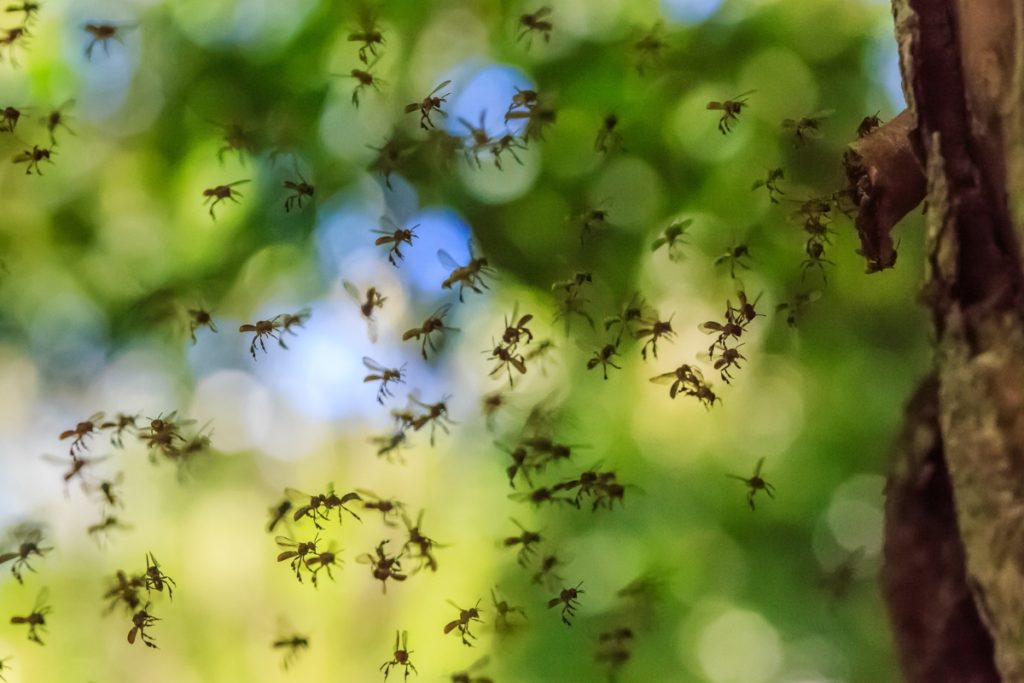Bees Nest Removal – What You Need to Consider
Bees are critical to the UK’s ecosystem, contributing significantly to pollination and supporting biodiversity. However, with over 250 species, including 25 different types of bumblebees, their nests can pose risks to people and property.
This article discusses some key factors to consider for efficient and safe bees nest removal, protecting humans and bees alike.

Identifying Bee Species from Property Damage
Honeybees
Honeybees live in large colonies with a queen. If nesting in buildings, their weight can damage structures. What’s more, their honeycomb nests can cause staining, warping, and potential mould growth, as well as attract pests like ants, wax moths and rodents – worsening the issue.
Bumblebees
Bumblebees tend to nest in smaller colonies within hollow spaces. They prefer dark cavities, often burrowing into insulation or soft materials. This can result in minor damage to walls and loft spaces. In rare cases, they may even chew through softwood for nesting.
Carpenter Bees
Carpenter bees bore holes and create tunnels in wood structures, causing property damage and potential safety hazards by weakening the wood over time.
They prefer excavating soft, rotten or unpainted wood, like decks, eaves, siding or outdoor furniture.
Mason Bees
Mason bees are solitary bees that nest on their own in materials like wood, brick and mortar.
Their nesting behaviour can contribute to the deterioration of building exteriors or wooden surfaces if holes are left unchecked over time.
Managing a Bees Nest in or Around the Home or Business
Bee Nests Should be Left Alone
Bees Nest Removal should be a last resort. Bees are vital pollinators that contribute significantly to the environment and agriculture. They generally do not pose a threat to you unless provoked or disturbed. Therefore, if bees are found in or around your home or business, and it is safe to do so, you may wish to leave them be to continue their pollination work.
Call a Professional
You’d be pleased to know that bees naturally relocate at the end of summer. However, if you discover a bee’s nest in a potentially unsafe area, it is essential to seek professional help to avoid any potential harm from the bees who may become agitated and sting.
A reputable bee removal specialist can safely relocate the nest, preventing any danger to you or your property. Therefore, it’s crucial to choose a specialist experienced in bee nest removal to ensure the well-being of both the bees and you.
DIY Tips to Encourage a Bee’s Nest to Relocate
Seal Holes
Certain bee species, including honeybees and bumblebees, can repeatedly build nests in the same location year after year.
Sealing entry points helps preserve your property, reduce pest risks and encourage bees to find safer and more suitable natural habitats, ultimately benefiting the environment.
Move Flowers Away from the Nest
Moving flowers away from a bee’s nest can naturally guide bees to a foraging location that is more suitable for nesting without causing harm to them or the environment.
In addition, maintaining a tidy garden and planting bee-repelling plants are non-invasive ways to encourage bees to relocate from their nest.
Use a Repellent
Essential oils like peppermint, cinnamon, tea tree and citronella can be a natural repellent for bees.
Similarly, mothballs contain potent chemicals that create an inhospitable odorous environment.
Both these methods effectively encourage bees to relocate to more suitable nesting locations.
Hang Fake Nests
Many bee species are territorial and avoid nesting near existing nests. Therefore, hanging fake bee nests can be an effective way to encourage relocation.
This chemical-free method simulates an established colony, prompting bees to find a more suitable location.
